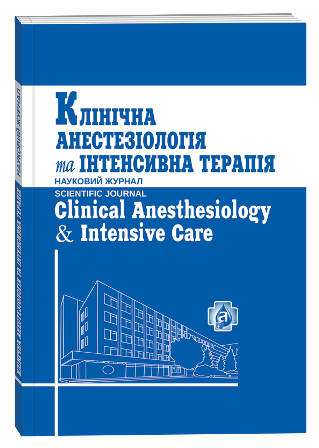THE OPTIMAL ANTICOAGULATION IN THE PERIOPERATIVE PERIOD IN CATHETER RADIO FREQUENCY ABLATION OF THE PULMONARY VEIN IN PATIENTS WITH ATRIAL FIBRILLATION
Keywords:
atrial fibrillation, anticoagulation regimes, catheter ablationAbstract
An important aspect of the intra-operative management of patients with atrial fibrillation (AF) is adequate anticoagulation to prevent thromboembolic complications. The most frequent complications of the so-called “silent” strokes up to 10% of the total number of complications. Excessive anticoagulation, in turn, can lead to hemorrhagic complications including hemopericardium and cardiac tamponade, hematoma after puncture site vessels. The aim of our research is to develop optimal perioperative anticoagulation regimes during catheter interventions for atrial fibrillation, based on the determination of the time of activation of coagulation (active clotting time, ACT) and the international normalizing ratio (INR) for the prevention of stroke, systemic embolism and bleeding complications. The study included 70 patients with paroxysmal AF, aged between 45 and 75 years who underwent radiofrequency catheter isolation of the pulmonary veins. There were 42 (64.3%) men and 28 (35.7%) women. The first group (I) included 30 patients who underwent bridging-therapy. Warfarin abolished in 2–3 days prior to the procedure and resumed at 4 h after surgery. The second group (II) included 40 patients who received warfarin dose 2.5–7.5 mg per day prior to surgery. In the perioperative period, warfarin was not canceled. In the perioperative period, heparin was administered intravenously at a dose of 130–150 IU/kg body weight bolus, depending on the initial levels of INR and ACT and their ratio. Subsequently, heparin was administered intravenously according to the ACT indicator. ACT levels were significantly higher in group II, wherein INR level was on average 2.3±0.8 (r=0.7; p<0.001). The initial dose of heparin in this group was significantly lower than in group I and was (10.234±543.000) IU (8.000–12.000) IU compared with group I — (12.600±550.000) IU. After the first injection of heparin in the perioperative period, ACT were significantly higher in patients in the second group who received warfarin entire perioperative period compared with patients who observed bridging-therapy (p<0.001). Each subsequent measurement of ACT showed significantly higher levels of ACT in the second group at lower injected heparin. Hemorrhagic complications, such as small bleeding (hematoma puncture site) were observed in 7 (23%) patients in bridging-therapy group and the 2nd group — 4 patients (10%). So, it was found an association between the level of INR, an indicator of the ACT and the total dose of heparin, which must be taken into account during the interventional treatment of AF in the prevention of thromboembolic complications in order to reduce the risk of hemorrhagic complications.
References
HRS/EHRA/ECAS Expert Consensus Statement on Catheter and Surgical Ablation of Atrial Fibrillation: Recommendations for Personnel, Policy, Procedures and Follow-Up: A report of the Heart Rhythm Society (HRS) Task Force on Catheter and Surgical Ablation of Atrial Fibrillation / H. Calkins, J. Brugada, D. L. Packer [et al.] // Heart Rhythm. – 2007. – Vol. 4 (6). – P. 816–861.
Worldwide survey on the methods, efficacy, and safety of catheter ablation for human atrial fibrillation / R. Cappato, H. Calkins, S. A. Chen [et al.] // Circulation. – 2005. – Vol. 111. – P. 1100–1105.
Initiation of atrial fibrillation by ectopic beats originating from the pulmonary veins: electrophysiological characteristics, pharmacological responses, and effects of radiofrequency ablation / S. A. Chen, M. H. Hsieh, C. T. Tai [et al.] // Circulation. – 1999. – Vol. 100. – P. 1879–1886.
Chen S. A. Catheter ablation of atrial fibrillation originating from the non-pulmonary vein foci / S. A. Chen, C. T. Tai // J. Cardiovasc. Electrophysiol. – 2005. – Vol. 16. – P. 229–232.
ACC/AHA/ESC 2006 guidelines for the management of patients with atrial fibrillation — a report of the American College of Cardiology/American Heart Association Task Force on Practice Guidelines and the European Society of Cardiology Committee for Practice Guidelines (Writing Committee to Revise the 2001 Guidelines for the Management of Patients With Atrial Fibrillation) / V. Fuster, L. E. Ryden, D. S. Cannom [et al.] // J. Am. Coll. Cardiol. – 2006. – Vol. 48. – P. e149–246.
Percutaneous ablation for atrial fibrillation: the role of cross-sectional imaging / B. Ghaye, D. Szapiro, J. N. Dacher [et al.] // Radiographics. – 2003. – Vol. 23. – P. S19–S33.
Electrophysiological breakthroughs from the left atrium to the pulmonary veins / M. Haissaguerre, D. C. Shah, P. Jais [et al.] // Circulation. – 2000. – Vol. 102. – P. 2463–2465.
Cerebral diffusion-weighted magnetic resonance imaging: a tool to monitor the thrombogenicity of left atrial catheter ablation / L. Lickfett, M. Hackenbroch, T. Lewalter [et al.] // J. Cardiovasc. Electrophysiol. – 2006. – Vol. 17. – P. 1–7.
Intracardiac ultrasound detection of thrombus on transseptal sheath: incidence, treatment, and prevention / K. Maleki, R. Mohammadi, D. Hart [et al.] // J. Cardiovasc. Electrophysiol. – 2005. – Vol. 16. – P. 561–565.
Circular mapping and ablation of the pulmonary vein for treatment of atrial fibrillation: impact of different catheter technologies / N. F. Marrouche, T. Dresing, C. Cole [et al.] // J. Am. Coll. Cardiol. – 2002. – Vol. 40. – P. 464–474.
A tailored approach to catheter ablation of paroxysmal atrial fibrillation / H. Oral, A. Chugh, E. Good [et al.] // Circulation. – 2006. – Vol. 113. – P. 1824–1831.
Risk of thromboembolic events after percutaneous left atrial radiofrequency ablation of atrial fibrillation / H. Oral, A. Chugh, M. Ozaydin [et al.] // Circulation. – 2006. – Vol. 114. – P. 759–765.
Segmental ostial ablation to isolate the pulmonary veins during atrial fibrillation: feasibility and mechanistic insights / H. Oral, B. P. Knight, M. Ozaydin [et al.] // Circulation. – 2002. – Vol. 106. – P. 1256–1262.
Mortality, morbidity, and quality of life after circumferential pulmonary vein ablation for atrial fibrillation: outcomes from a controlled nonrandomized long-term study / C. Pappone, S. Rosanio, G. Augello [et al.] // J. Am. Coll. Cardiol. – 2003. – Vol. 42. – P. 185–197.
Increased intensity of anticoagulation may reduce risk of thrombus during atrial fibrillation ablation procedures in patients with spontaneous echo contrast / J. F. Ren, F. E. Marchlinski, D. J. Callans [et al.] // J. Cardiovasc. Electrophysiol. – 2005. – Vol. 16. – P. 474–477.
Atrial Fibrillation Ablation in Patients With Therapeutic International Normalized Ratio / O. M. Wazni, S. Beheiry, T. Fahmy [et al.] // Circulation. – 2007. – Vol. 116. – P. 2531– 2534.
Embolic events and char formation during pulmonary vein isolation in patients with atrial fibrillation: impact of different anticoagulation regimens and importance of intracardiac echo imaging / O. M. Wazni, A. Rossillo, N. F. Marrouche [et al.] // J. Cardiovasc. Electrophysiol. – 2005. – Vol. 16. – P. 576–581.







